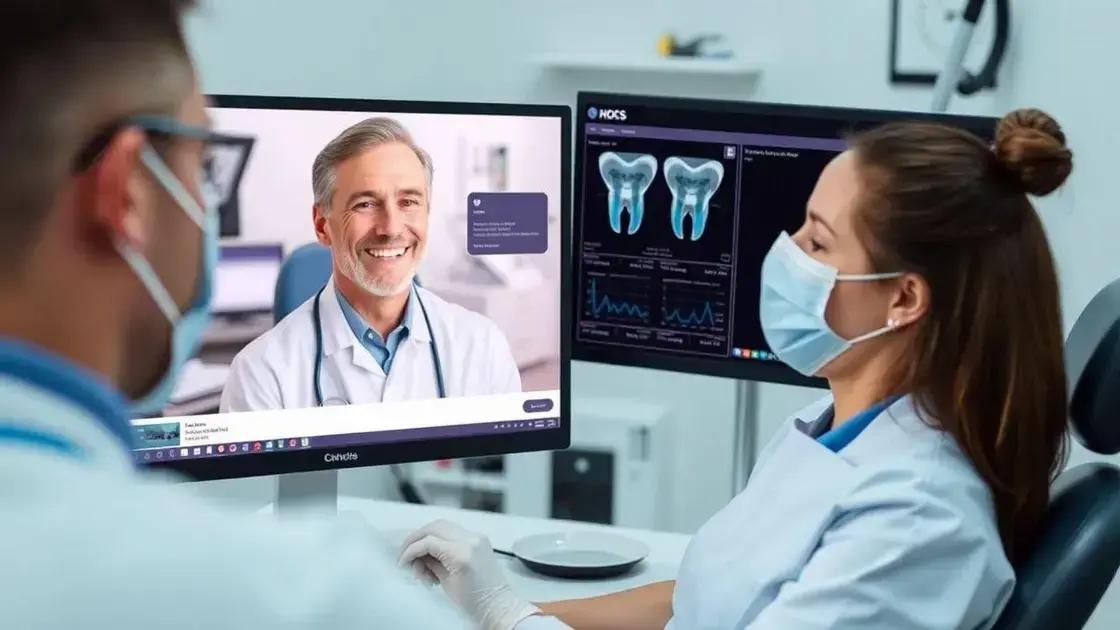Telehealth innovations for chronic disease management

Telehealth innovations for chronic disease management enhance patient access to care, improve communication between patients and providers, and utilize technology for effective monitoring and personalized treatment plans.
Telehealth innovations for chronic disease management are reshaping how patients interact with healthcare providers. Have you ever wondered how technology can simplify health management? Let’s dive into this exciting topic!
Exploring telehealth technologies
Telehealth technologies have transformed patient care in many ways. By using software and devices, healthcare providers can now offer support remotely, making healthcare more accessible. This is especially important for people with chronic diseases, as they can receive necessary care without frequent trips to the hospital.
Types of Telehealth Technologies
Several telehealth technologies are currently enhancing the management of chronic diseases. These include:
- Video Conferencing: Patients can have face-to-face conversations with healthcare providers through video calls.
- Remote Monitoring Devices: These devices track vital health metrics, such as blood pressure and glucose levels, sending data directly to medical professionals.
- Mobile Health Apps: Apps help manage medications and provide resources for chronic disease education.
Each of these tools plays an essential role in various aspects of patient care. For instance, video conferencing enables ongoing communication, while remote monitoring provides real-time data, allowing providers to make timely decisions.
Benefits of Using Telehealth Technologies
Incorporating telehealth into chronic disease management offers numerous advantages. Patients experience increased convenience, reduced travel time, and often quicker access to healthcare professionals. Furthermore, telehealth can decrease the risk of hospital readmissions by allowing for regular check-ins.
Consider how busy schedules can make in-person visits difficult. With telehealth, patients can connect with their providers from the comfort of home. This flexibility makes it easier for patients to adhere to treatment plans.
Challenges of Telehealth Technologies
Despite its many benefits, integrating telehealth technologies poses challenges. For example, some patients may lack access to reliable internet or smartphones. Others might feel uneasy about using technology for their healthcare.
It’s also important to ensure that healthcare professionals are trained to use telehealth tools effectively. Overcoming these barriers will be key to maximizing the potential of telehealth in chronic disease management.
In conclusion, exploring the landscape of telehealth technologies reveals substantial opportunities for improving patient care. As these tools continue to evolve, they promise to make healthcare more efficient and patient-centered.
Benefits of telehealth for chronic diseases

Telehealth offers many benefits, especially for those managing chronic diseases. Here are some key advantages that make telehealth an appealing option for patients and healthcare providers alike.
Improved Access to Care
One of the most significant benefits of telehealth is that it improves access to medical care. Patients living in remote areas or with mobility issues can easily connect with their doctors without traveling long distances. This immediate access to healthcare is crucial, especially for patients who require regular appointments.
Convenience and Flexibility
Telehealth brings convenience to patients by allowing them to schedule appointments at times that suit them. Whether it’s during a lunch break or from the comfort of home, they can attend consultations without the hassle of commuting.
- Time savings: Less time spent traveling means more time for patients.
- Reduced missed appointments: With telehealth, there’s less chance of skipping appointments due to transportation issues.
- Quick response times: Patients can often receive immediate feedback on their health concerns.
Engaging with healthcare providers through telehealth empowers patients to take charge of their health while addressing their concerns more effectively.
Enhanced Communication
Telehealth fosters improved communication between patients and providers. With continuous access to their healthcare team, patients can ask questions and share updates more freely. This close communication helps doctors monitor conditions more effectively, making adjustments to treatment as needed.
Regular check-ins can provide peace of mind, ensuring that patients feel supported throughout their healthcare journey. They are less likely to experience feelings of isolation or uncertainty when they have consistent contact with their medical team.
Cost-Effectiveness
Using telehealth can often be more cost-effective for patients. By eliminating travel costs and saving time, many find that telehealth visits are more affordable than traditional in-person visits. Additionally, healthcare systems can reduce overhead costs, potentially passing those savings on to patients.
The combination of convenience, enhanced communication, and cost-effectiveness makes telehealth a powerful tool in chronic disease management, ensuring patients get the care they need effectively and efficiently.
Challenges in adopting telehealth
While telehealth offers numerous advantages, several challenges exist in adopting these technologies. Understanding these barriers is essential for healthcare providers and patients alike.
Access to Technology
A significant hurdle is access to the necessary technology. Not everyone has a smartphone, tablet, or computer capable of supporting telehealth services. This limitation can leave patients without reliable access to care, especially those in rural areas or low-income households.
Digital Literacy
Another challenge is digital literacy. Many patients may feel uncomfortable or lack the skills needed to navigate telehealth platforms. This can create a barrier to receiving care, as some individuals may hesitate to use technology for their health needs.
- Training Required: Patients often need help to become comfortable with telehealth tools.
- Generational Gaps: Older adults may have more difficulty adapting to new technologies.
- Provider Training: Healthcare providers must be trained to assist patients through tech challenges.
Enhancing digital literacy is vital for ensuring that all patients can benefit from telehealth.
Insurance and Reimbursement Issues
Insurance coverage for telehealth services can also present challenges. Some insurance providers may not fully cover virtual visits, leading to confusion and hesitation among patients. This uncertainty can deter individuals from using telehealth options, slowing the adoption rate in various communities.
Also, reimbursement policies often change, making it difficult for healthcare providers to navigate billing for telehealth services. Understanding these policies is essential for both patients and providers to maximize the benefits of telehealth.
Privacy and Security Concerns
Concerns about privacy and security also pose challenges in the adoption of telehealth. Patients worry about the safety of their personal health information when using digital platforms. Ensuring proper security measures are in place is crucial for building patient trust in telehealth solutions.
Addressing these concerns will help pave the way for wider acceptance of telehealth, ensuring that patients feel safe when seeking remote care.
Future trends in telehealth management

The future of telehealth management looks promising with several emerging trends that are set to transform patient care. As technology continues to advance, it creates opportunities for improving the efficiency and effectiveness of healthcare delivery.
Integration of AI and Machine Learning
Artificial Intelligence (AI) and machine learning are becoming more prevalent in healthcare. These technologies can analyze vast amounts of patient data, helping to predict health issues before they arise. By leveraging AI in telehealth, healthcare providers can offer personalized treatment plans, improving patient outcomes.
Expansion of Remote Patient Monitoring
Remote patient monitoring (RPM) is gaining traction as a vital part of chronic disease management. With wearable devices and mobile applications, patients can track their health metrics in real-time. This continuous data flow allows healthcare professionals to monitor patients closely, adjusting treatment plans as needed.
- Wearable Devices: Smartwatches and fitness trackers can provide critical health data.
- Mobile Health Apps: Applications that help patients manage their conditions more effectively.
- Data Analytics: Analyzing collected data to provide insights into patient health trends.
Such advancements lead to more proactive care and ultimately improve health outcomes.
Regulatory Changes and Increased Adoption
As telehealth continues to evolve, regulatory bodies are adapting to this change. We can expect to see more comprehensive policies supporting telehealth services. These changes will encourage both patients and providers to embrace telehealth as a standard practice.
Additionally, with the growing acceptance of telehealth, more healthcare facilities will integrate these services into their offerings, ensuring that patients have access to a broader range of care options.
Focus on Mental Health Services
The importance of mental health services through telehealth is gaining recognition. Many patients find it easier to seek help for mental health issues through virtual platforms. Mental health apps and teletherapy sessions are becoming more common, ensuring that individuals receive support when they need it most.
As society continues to prioritize mental well-being, telehealth services will adapt to meet these needs efficiently, ensuring comprehensive care for both physical and mental health challenges.
FAQ – Frequently Asked Questions about Telehealth Innovations for Chronic Disease Management
What are the main benefits of telehealth for chronic disease management?
Telehealth improves access to care, enhances communication between patients and providers, and allows for better monitoring of health conditions.
How can technology help in managing chronic diseases?
Technology such as remote monitoring devices and mobile health apps enables patients to track their health metrics and receive personalized care.
What challenges do patients face when using telehealth services?
Patients may struggle with access to technology, digital literacy, and privacy concerns, which can hinder their ability to use telehealth effectively.
What future trends can we expect in telehealth?
Future trends in telehealth include greater integration of AI for personalized treatment, expanded remote monitoring, and a stronger focus on mental health services.





